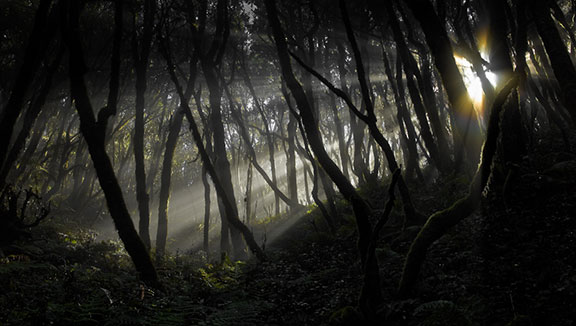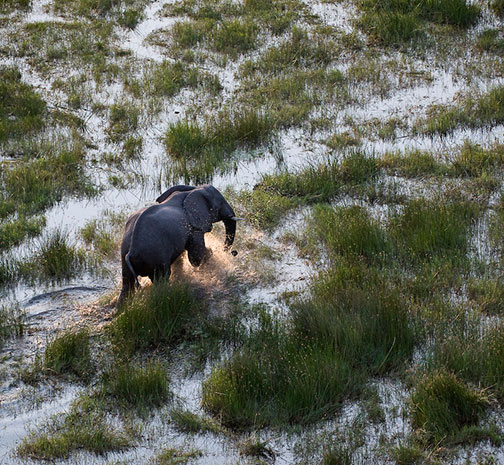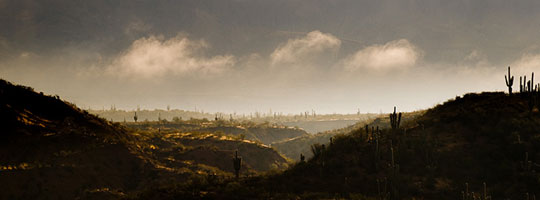
Garajonay Dawn. La Gomera. Canary Islands. Spain. January, 2010
Leica M9 with Tri-Elmar @ 35mm. ISO 250
Recovering from a major surgical procedure recently I spent three days attached to an on-demand epidural drip and then a further four days on morphine-based pain killers. While these are effective in post-surgical pain management they also place the brain in a twilight zone where clear thinking and analysis play second fiddle to counting the number of dragon heads woven into the window curtains next to my bed. (Post narcotic dragon count –none. All simply the mind’s attempt at patterning).
Excluding the dragon counting episode there isn’t much to do mentally while floating in a narcotic haze. Regular television is off the table – I don’t want my body to heal while my brain is turned to pablum; not dissimilar from what I was asked to eat for breakfast. My iPad was a worthy companion during this period of convelescence, with favourite web sites, news feeds, magazines, movies and other distractions.
But in the end narcotics for pain and clear rational thought are irreconcilable bed fellows, and so I would simply spend long hours in lotus land, contemplating mortality, why the Toronto Maple Leaf’s haven’t won the Stanley Cup since 1967, and what’s really going on in the photographic industry. Of the three I figure that my addled thinking about the camera industry might be of some interest to others.
Kidding or Not
There’s a character online in the photographic community who operates a pretty popular web site, mostly about new gear. His claim to fame is that he appears to write the first thing that comes to mind, whether based on fact, research and analysis, or simply whim. When his mistakes, misstatements and sometime downright blunders are pointed out he takes refuge in writing “I have a big sense of humor, and do this site to entertain you (and myself)…. I occasionally weave fiction and satire into my stories to keep them interesting. I love a good hoax“.
OK, I get it. But this does seem akin to the teenager who when confronted with a deceit or a hurtful comment, takes refuge in the time-worn phrase “Just Kidding“. We just know, don’t we, that when someone say “just kidding” just the opposite is actually true. They are using the words to slither out from under responsibility for what was said.
Regular readers know that my writings are meant to mean what they say. I make occasional mistakes, and when I do I try and correct them as soon as possible, and also make the error known. Which brings us to the essay below.
The observations below are derived from the week or so of post-surgery when I had little else to do than ponder cosmic mysteries – including the photographic industry. But, I am now as sober as ever, and as US politicians say in their campaign ads –I am responsible for this message.
Uncensored Observation
I began working as a photographer in 1965, after university, with subsequent branches off into broadcast TV, film production, software development, software publishing, product management, retail management, and acting as co-founder of a VC funded start-up, then listed company, in the software and telecommunications industry. Nevertheless I have always stayed pretty close to the photography community and industry, writing, teaching and of course shooting.
RAW
It’s long overdue for camera companies to face up to the fact that they can’t write decent raw software. They should do their customers a favour and stop insulting us with thedreckthat they produce. Talk to a raw software engineer (as I have on numerous occasions) and you’ll be told that most raw files are 90+% the same. There are some proprietary twists now and then, but unless a manufacturer is deliberately trying to be obtuse, or has some novel alternative colour matrix, raw files are quite similar. Yes, they are loaded these days with lens correction data fields, but this is all pretty much straightforward.
So, why do we have proprietary raw files from almost all camera makers? Corporate ego. Nothing more.
Nikon, Canon, Sony, Panasonic, et al –give it up! You are doing a disservice to your customers. Either adopt the DNG standard, or some other standard if you can find one. Stop wasting time and resources on producing V13.6 of your own usually underperforming raw software and leave the companies that know how to do it well do so. Apple, Adobe, Phase One and DxO all write powerful, full-featured raw image processing software. These are what 95% of advanced amateurs and pros use, so please, let go of your ego trip, and do the right thing by adopting a standard raw file format. Your customers will thank you when you do, but will continue to curse you if you don’t.
Canon
Howler Monkey – Costa Rica, 2001
Canon EOS D30 and 100~400mm f/5.6L lens @ 400mm
Canon is the market leader. As is often the case when companies achieve that status, regardless of field, they tend to become overly conservative. Think Toyota. Think Microsoft. Not a bad thing to be the biggest, but it usually robs a company of hunger and leads to their playing things safe.
This year one just needs to look at the 5D MKIII and EOS-M. The new 5 is a highly competent camera, but some three years since its predecessor doesn’t offer anything other than incremental enhancements. Even though the 5D MKII was the harbinger of the DSLR video marketplace the III still can’t output a “clean” HDMI signal to allow recording to external devices. Why not?
The EOS-M, Canon’s initial answer to the mirrorless segment, is so me-too and unexciting that it might as well be a Toyota Camry.
This of course begs the question – what’s wrong with unexciting? Unexciting can sell a lot of product, especially when it’s well engineered and well built, as most Canon (and Toyota) products are. But for the photography enthusiast (which you likely are if you’re reading this) there isn’t much to get excited about. And it’s excitement that generates upgrade and cross-over sales, isn’t it?
On the bright side, the group within Canon responsible for the new C series large sensor video cameras appear to be highly innovative and able to create a series of very competent (though expensive) new products. If only some of this group’s creativity could find its way back to the regular stills camera division.
Nikon

Returning Home – Botswana, September 2008
Nikon D3 with 200-400mm f/ 4 lens @ ISO 3200
Around 2005 Nikon had hit the wall. Though the D1 had kick-started the DSLR revolution a half decade earlier, Canon had quickly steamed ahead and things were not looking good for Nikon’s prospects in the pro and advanced amateur marketplace. The well known story is that the company’s board lost patience, chopped a lot of senior heads, and told a group of young Turks – Make us #1 again.
The results of that revolution have been evident for the past five years or so with the company moving from strength to strength with each new model introduction. Nikon’s D800/E has captured the imagination of a great many photographers, and if anecdotal evidence from dealers is to be believed has caused more than a few defections from the Canon ranks.
These things go in cycles. In the 1990’s Nikon lost a lot of business to Canon when that company introduced its L series super telephoto lenses (300 – 600mm). It was years till Nikon would counter that thrust.
The one area where Nikon lags its peers is in “openness”. Nikon controls its communications very closely, and has also not learned the Western approach to damage control. Case in point, the widely publicised D800/E focus problem. To their credit, Nikon has found it and is fixing the issue. But they have not as yet made any public acknowledgement. Any Western PR firm would tell them to get out in front of the story early, explain what’s going on, and then publicise the fix. But whether they’ve received such advise or not, Nikon remains silent on the matter (late July, 2012) .
Sony

Arizona Welcome. Coronado National Forest, Arizona. November, 2008
Sony A900 with Sony 70-300mm f/4.5-5.6
When Sony purchased Minolta it was clear that still photography would become a strategic market for them. The past five years or so have shown this to be the case, and Sony has proven to be a fierce competitor, as they are in every market that they attack. Part of Sony’s strength lies in that they are one of the world’s largest semi-conductor manufacturers, and indeed they make the sensors that appear in quite a few of their competitor’s cameras.
When it comes to their own designs Sony has shown themselves to be innovative if nothing else. Their Translucent Mirror technology along with high quality EVFs points towards a mirrorless future (glass prisms and mirror assemblies are much more expensive to manufacture, and are not video friendly) and though abandoning the prism/ mirror may lose them some sales, Sony is not hesitant in knowing what they have to do.
Certainly their NEX cameras show an ability to innovate, with a range of cameras with APS-C sized sensors that are actually more compact than MFT. Though NEX got off on the wrong foot with its truely dreadful user interface, Sony was quick to try and improve it, and with the hugely sucessfulNEX-7has produded a highly useble interface in the NEX mold. Still not as good as their Alpha interface, but quite OK.
Recently, with theRX-100Sony has scored another apparent home run, providing enthusiast photographers with something that they’ve been asking for for years – a pocketable large sensor high-resolution camera that isn’t a compromise.
Olympus
Olympus E-1 with 14-54mm f/2.8-3.5 lens @ ISO 100
The “comeback kid” of the cameras industry is, in my opinion, Olympus. Always a highly respected though marginal player, Olympus was an early proponent of the Four Thirds format. The mistake that they made was to pitch it to pros, at a time when sensor technology simply didn’t allow for the image quality that pros and enthusiasts demanded and got from full-frame.
Their initial MFT offerings were interesting, but didn’t convince. Now though, with theOM-D E-M5they have resurrected their original gestalt, producing an enjoyable to use, high quality, beautifully built small system camera. Notwithstanding Olympus’ recent horrendous accounting scandal, if they can produce a convincing product such as the M5 under such stressful conditions I have no doubt that in better times they will be capable of putting their larger competitors to shame.
Panasonic

Faces – Toronto. November, 2008
Panasonic G1 with 40-200mm @ ISO 250
Back in the 1980’s, before Betamax, VHS and consumer video in general, I was National Sales Manager for the industrial and broadcast video division at Panasonic Canada. Over a five year period I learned from the inside quite a bit about how Japanese companies, and Panasonic in particular, functions. Here’s one anecdote.
This was the era of the U-Matic format, a cross-brand professional video cassette. Then Sony introduced Betamax, and JVC/Panasonic the VHS format, first for industrial and educational applications. Camcorders, editing and switching gear followed.
As Panasonic and Sony fought it out in the market I recall one seminal meeting with a senior product planning executive from Japan. I was complaining how Sony seemed to constantly have superior technology and able to get it to market sooner than our company. (Betamax was indeed superior to VHS). His reply was revealing. He said that Panasonic was not interested in being first with the latest and greatest. They were interested in producing solid products that met market demands and which could generate volume sales and good margins. They were happy to let Sony (and even Panasonic’s then sister company JVC) take the bleeding edge.
Being a competitive marketeer I was not happy with this approach. But over the years I learned the wisdom of it, and it has allowed Panasonic to become one of the world’s largest consumer electronic companies.
I’m not saying that this approach applies to Panasonic today in the still photography market. But one does see a somewhat cautious –go for the gold not the glory– approach in evidence. One example of this is the GH2. When introduced it was arguably the finest video capable still camera yet. It blew the doors off the Canon 5DMKII when it came to video image quality. But whereas Canon realized that they had stumbled into a new market, and nurtured and developed it, Panasonic didn’t. Hackers famously took the GH2 and tweaked its performance to an almost ridiculous extent. To their credit Panasonic didn’t close the camera’s firmware to these exploits, but neither did they foster and encourage the adoption of the GH2 by the video community. The rest is history.
August, 2012
Opinion
As should be readily apparent, this is an opinion piece. It is therefore subject to being agreed with or disagreed with in whole or in part. If you have something to say or add please do so on this site’sdiscussion forum.
You May Also Enjoy...
VJ12 Workflow
Subscribe to The Video Journal Please use your browser'sBACKbutton to return to the page that brought you here.
Featured Images 2000
This page features selected photographs from my portfolio taken during 2000that I am particularly pleased with and for which there is an interesting story. Current entries can


